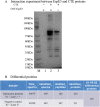EspE3 plays a role in the pathogenicity of avian pathogenic Escherichia coli
- PMID: 37644523
- PMCID: PMC10463865
- DOI: 10.1186/s13567-023-01202-9
EspE3 plays a role in the pathogenicity of avian pathogenic Escherichia coli
Abstract
APEC encodes multiple virulence factors that have complex pathogenic mechanisms. In this study, we report a virulence factor named EspE3, which can be secreted from APEC. This protein was predicted to have a leucine-rich repeat domain (LRR) and may have a similar function to IpaH class effectors of the type III secretion system (T3SS). For further exploration, the regulatory correlation between the espE3 and ETT2 genes in APEC was analysed. We then assessed the pathogenicity of EspE3, detected it in APEC secretion proteins and screened the proteins of EspE3 that interact with chicken trachea epithelial cells. This study provides data on a new virulence factor for further exploring the pathogenic mechanism of APEC.
Keywords: APEC; ETT2; EspE3; effector; pathogenicity.
© 2023. L’Institut National de Recherche en Agriculture, Alimentation et Environnement (INRAE).
Conflict of interest statement
The authors declare that they have no competing interests.
Figures







References
-
- Xia F, Jiang M, Wen Z. Complete genomic analysis of ST117 lineage extraintestinal pathogenic Escherichia coli (ExPEC) to reveal multiple genetic determinants to drive its global transmission: ST117 E. coli as an emerging multidrug-resistant foodborne ExPEC with zoonotic potential. Transbound Emerg Dis. 2022;69:3256–3273. doi: 10.1111/tbed.14678. - DOI - PubMed
MeSH terms
Substances
Grants and funding
LinkOut - more resources
Full Text Sources

